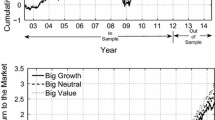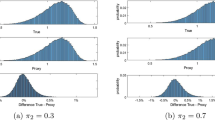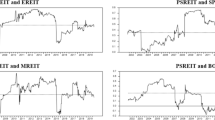Abstract
In this article, I propose an extension of the Treynor–Black model to a case where the investor is not fully invested in the stock market at the outset and there is no need to explicitly specify securities’ expected returns. I derive explicit tangent portfolio weights based on a factor model of securities’ expected returns. The computational burden of the model is linear in the number of securities in the portfolio and does not involve any matrix inversion. I present an empirical application using the market model of Sharpe, the three-factor model of Fama and French and the four-factor model of Carhart with up to 30 industry portfolios between 1963 and 2012 and up to 1000 US stocks starting in 1992 until 2012. The portfolios perform well out-of-sample relative to the entire US value-weighted stock market portfolio with dividends reinvested from the Center for Research in Security Prices. The proposed framework can be extended in a straightforward way to time-varying factor models with multiple state variables affecting securities’ expected returns and factor loadings.






Similar content being viewed by others
Notes
Note that this is not strictly required in general. D can be a non-diagonal matrix if securities’ return innovations are expected to have non-zero covariances. A good example of this is securities of firms within the same industry as they are likely to be exposed to industry-specific shocks that will induce non-zero covariances between their return innovations. The general formulae that follow will hold for non-diagonal D as well but will then require the inversion of a large matrix when the tangent portfolio contains a large number of securities.
To see this, set x=D−1/2α and y=D−1/2β. Then (α′D−1α)(β″D−1β)−(α'D −1β)2=(x′x)(y′y)−(x′y)2⩾0.
The same argument applied previously to D applies here similarly to Ω.
This results in approximately 250 daily returns used for the estimation of α, β and D for the single-factor model and α, B and Ω for the multiple-factor model. Using an alternative estimation window of as few as 100 days or as many as 500 days yields qualitatively similar results. The findings of this robustness check are available from the author upon request.
The daily portfolio and factor return data as well as daily risk-free interest rates are obtained from Ken French’s online Data Library.
The RAR is given by the difference between the total cumulative return of the portfolio and the total cumulative return of the benchmark, that is, RAR=Πt=1t=T(1+r p, t )−Πt=1t=T(1+r b, t ), where rp, t is the total return of the portfolio in period t,rb, t is total return of the benchmark in period t and Π is the product operator.
The α reported is the abnormal return of the portfolio relative to the benchmark, that is,
 , where
, where  and
and  are the average returns of the portfolio and the benchmark, respectively, and β
p
is the β of the portfolio with respect to the benchmark.
are the average returns of the portfolio and the benchmark, respectively, and β
p
is the β of the portfolio with respect to the benchmark.The findings regarding the performance of this algorithm using the FF3 and C4 models of securities’ returns is available from the author upon request.
References
Carhart, M.M. (1997) On persistence in mutual fund performance. Journal of Finance 52 (1): 57–82.
Dybvig, P.H. (2005) The fallacy of large numbers. Journal of Applied Finance 15 (2): 5–12.
Elton, E.J., Gruber, M.J. and Padberg, M.W. (1976) Simple criteria for optimal portfolio selection. Journal of Finance 31 (5): 1341–1357.
Elton, E.J., Gruber, M.J. and Urich, T.J. (1978) Are betas best? Journal of Finance 33 (5): 1375–1384.
Fama, E.F. and French, K.R. (1992) The cross-section of expected stock returns. Journal of Finance 47 (2): 427–465.
Ferguson, R. (1975) Active portfolio management – How to beat the index funds. Financial Analysts Journal 31 (3): 63–72.
Glabadanidis, P. (2013) Portfolio strategies to track and outperform a benchmark. University of Adelaide Business School, Working Paper.
Jegadeesh, N. (1990) Evidence of predictable behavior of security returns. Journal of Finance 45 (3): 881–898.
Kane, E., Kim, T.-H. and White, H. (2011) Active portfolio management: The power of the Treynor-Black model. In: C. Kyrtsou and C. Vorlow (eds.) Progress in Financial Markets Research, New York: Nova Publishers, pp. 311–332.
Markowitz, H.M. (1952) Portfolio selection. Journal of Finance 7 (1): 77–91.
Merton, R.C. (1973) An intertemporal capital asset pricing model. Econometrica 41 (5): 867–887.
Sharpe, W.F. (1964) Capital asset prices: A theory of market equilibrium under conditions of risk,. Journal of Finance 19 (3): 425–442.
Treynor, J. and Black, F. (1973) How to use security analysis to improve portfolio selection. Journal of Business 46 (1): 66–86.
Vasicek, O. (1973) A note on using cross-sectional information in Bayesian estimation of security betas,. Journal of Finance 28 (5): 1233–1239.
Woodbury, M.A. (1950) Inverting modified matrices. Memorandum Report 42, Statistical Research Group, Princeton, NJ.
Acknowledgements
The author would like to thank Turan Bali, Ron Bird, Evan Gatev, Berowne Hlavaty, Anthony Neuberger, Stephen Satchell (the editor), two anonymous referees, as well as participants in the 2013 J.P. Morgan quantitative conference in Sydney and seminar participants at the University of Adelaide for their valuable suggestions and comments. Any remaining errors are the author’s own.
Author information
Authors and Affiliations
Corresponding author
Additional information
1obtained his PhD from the Olin School of Business at Washington University in St. Louis. He has worked at Koç University in Istanbul, Turkey before moving to the University of Adelaide. His research interests are in the fields of financial econometrics and applied asset pricing theory.
Appendix
Appendix
In order to derive equations (5) and (6) in sub-section ‘Single-factor model of returns’, we use the binomial inverse theorem for V−1 and perform the multiplication with μ as follows:

Note that the last two terms in equation (A.1) above can be combined as follows:

Combining equation (A.2) with the second term in equation (A.1) leads to:

Finally, combining equation (A.3) with the first term in equation (A.1) produces the stated result in equation (5) in sub-section ‘Single-factor model of returns’. To obtain equation (6), we substitute α=0 into equation (5) that leads to the following:

Note that the quantity in the large parentheses above is a scalar. Hence, we have that:

which, because of the diagonal nature of D−1, leads to equation (6) as stated in sub-section ‘Single-factor model of returns’.
In a similar spirit, we can obtain equations (14) and (15) in sub-section ‘Multiple-factor return models’ using the binomial inverse theorem for V−1 and multiplying through with μ:


The two terms in eqaution (A.7) can be collected as follows:

which leads to:

after collecting some terms. The final step involves collecting the second term in equation (A.6) with equation (A.5) and collecting terms:

producing the stated result in equation (14). The special case of α=0 in (15) obtains by substituting α=0 in equation (A.9) leading to:

Rights and permissions
About this article
Cite this article
Glabadanidis, P. Tangent portfolio weights without explicitly specified expected returns. J Asset Manag 15, 177–190 (2014). https://doi.org/10.1057/jam.2014.22
Received:
Revised:
Published:
Issue Date:
DOI: https://doi.org/10.1057/jam.2014.22





 , where
, where  and
and  are the average returns of the portfolio and the benchmark, respectively, and β
p
is the β of the portfolio with respect to the benchmark.
are the average returns of the portfolio and the benchmark, respectively, and β
p
is the β of the portfolio with respect to the benchmark.